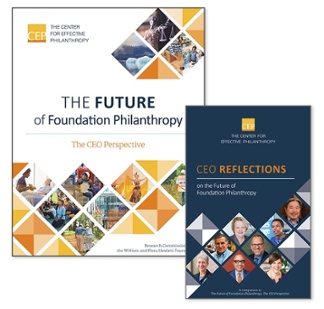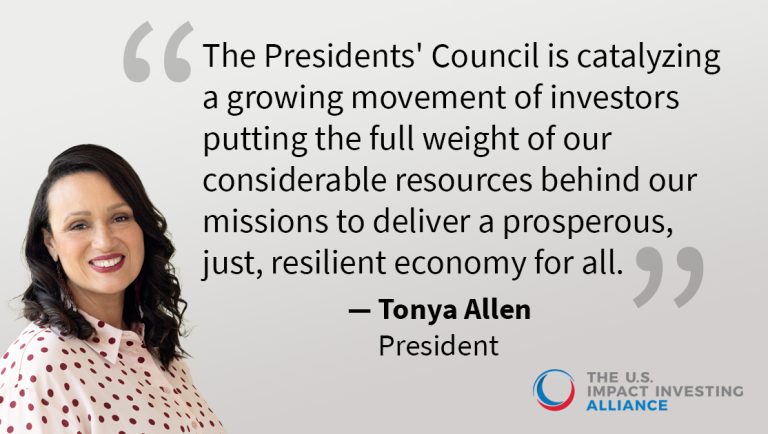This essay was originally published in a report by the Center for Effective Philanthropy called “CEO Reflections on the Future of Foundation Philanthropy.”
The Future of Foundation Philanthropy highlights “promising practices” in philanthropy, such as providing long-term general operating support, offering greater transparency, and learning from grantees. Agreed. But by now, the benefits of these practices are familiar to most of us thanks to the thoughtful exploration I’ve witnessed across the foundation community.
In this response, I prefer to focus on one area which foundation CEOs rate as “less promising” because, in my opinion, it remains largely unexplored by foundation leadership: our investments. In fact, I believe our endowments offer the promise of significantly increasing our collective influence on the pressing issues identified in the study, including inequality and climate change.
If we want to optimize our impact, it is time to give equal weight to our fiduciary duty of obedience to philanthropic mission.
 One underexplored opportunity is to shift to an integrated understanding of what it means to be a philanthropic fiduciary. More often than not, fiduciary duty is framed by foundation board and staff leadership only in relation to upholding legal requirements and preserving a foundation’s endowment. But thinking in the marketplace and among foundation regulators is changing.
One underexplored opportunity is to shift to an integrated understanding of what it means to be a philanthropic fiduciary. More often than not, fiduciary duty is framed by foundation board and staff leadership only in relation to upholding legal requirements and preserving a foundation’s endowment. But thinking in the marketplace and among foundation regulators is changing.
If we want to optimize our impact, it is time to give equal weight to our fiduciary duty of obedience to philanthropic mission. As a philanthropic fiduciary, we would embrace our role as institutional owners of our assets alongside our traditional role as grantmakers. We would consider the use of all of our resources to advance mission and public benefit, rather than just the five percent required payout for charitable purpose.
Making this shift sits squarely in the realm of governance. It requires a shared understanding and commitment of the board of directors as well as staff leadership. Such a shift allows a foundation to explore many additional approaches and tools that enhance our leverage. Without that fundamental shift in mindset, however, our field will limit ourselves to the margins of the market, rather than optimize our power to influence the market for public benefit.
Many foundations have a goal of maximizing financial return so that they can meet their grantmaking requirements, maintain purchasing power over time, and exist in perpetuity. Boards, investment committees, and CEOs operate with a longstanding assumption of conventional investing, namely that environmental, social, and governance (ESG) considerations constitute “constraints” that result in lower financial returns and/or additional portfolio risk. Therefore, they maintain harmful silos between the investment side of the house and the rest of the foundation.
A growing body of evidence, however, supports the premise that you do not have to sacrifice financial return—and may potentially enhance it— by incorporating ESG. Many larger institutional investors such as pension funds, insurance companies, and asset managers consider it reasonable and prudent to consider both ESG factors that constitute material downside risk to a portfolio, as well as ESG opportunities that can meet or exceed the financial returns. For foundations it has the added benefit of better aligning with philanthropic mission.
In September 2015, the IRS released guidance confirming the ability of foundations to “consider the relationship between a particular investment and the foundation’s charitable purpose” so long as ordinary business care and prudence are exercised and documented. This removes another barrier often cited by foundation leadership to deconstructing silos between mission and their investment function.
We would consider the use of all of our resources to advance mission and public benefit, rather than just the five percent required payout for charitable purpose.
More foundation dollars are flowing into impact investing. Like a growing number of our peers, The McKnight Foundation identified a portion of our endowment for mission-supportive investing. In this impact investing “carve out,” we seek financial returns comparable to conventional investments in the same asset class, alongside social/environmental and program learning returns. As we deploy those funds, more of our endowment capital is aligned with our mission. This market-oriented engagement makes us smarter in all our work and increases our impact.
Having said this, by focusing primarily on the investment tools themselves, McKnight was still leaving something on the table. It was when we refocused on our identity as an institutional investor that we began to leverage the power of our entire endowment. “Investor engagement” is an option which wasn’t even mentioned in the report. Yet, every foundation could play an incredibly powerful role wearing their institutional investor hat—without even moving a single dollar!
As a paying customer of financial products and services, our investment committee now asks all of our external financial managers about their ESG processes. Since we began, we have seen a significant shift in the awareness and embrace of ESG considerations by managers. McKnight provided the seed investment for an existing manager to launch a new institutional quality ESG product. We join with other institutional investors (not just foundations, but also large pension funds, insurance companies, asset managers, and such) in proxy voting and shareholder engagement because we are an owner of publicly traded companies. And we are using our voice at the U.S. Securities and Exchange Commission and with other market regulators to build healthy, longterm markets.
Not every investment strategy will make sense for every foundation. However, I suggest we move beyond talking only about investment tools and look at the bigger opportunity to position our foundations to optimize all of our resources to advance our mission. Along with our roles as grantmakers, convenors, and collaborators, let’s embrace our identity as institutional investors. This pivot will allow foundations to influence and shape capital markets in ways that advance public benefit and address pressing issues for lasting results.


